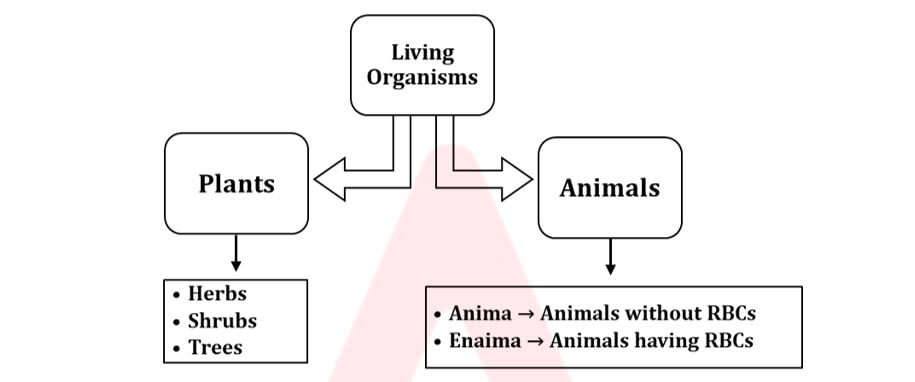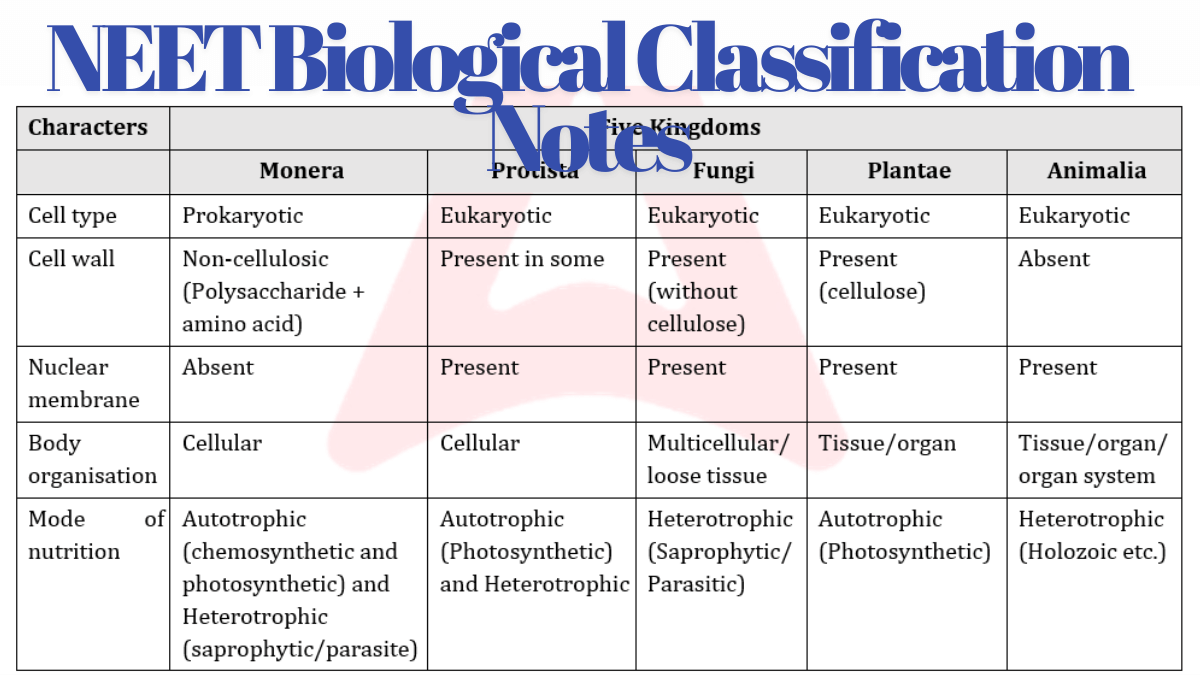Biological Classification NEET Notes: Biological classification is a scientific method for categorizing species based on their similarities, differences, and evolutionary links, and organizing them into hierarchical systems. Since ancient times, numerous attempts have been made to classify species. However, many early approaches were based primarily on human utility, such as their use for food, shelter, and clothing, and lacked a scientific foundation. Over time, increasingly detailed classification systems have arisen, emphasizing morphological, physiological, reproductive, and phylogenetic (evolutionary) aspects. In this biological Classification chapter NEET Notes, we will look at the features of the kingdoms Monera, Protista, and Fungi using Whittaker’s classification system, as well as a quick summary of the Kingdoms Plantae and Animalia.
Biological Classification NEET Biology Notes
From here, you will find the NEET Biology Notes for the class 11 Biology chapter –
Kingdom System of Classification
The earlier systems of classification of organisms were simple and based on one or two characters. Aristotle performed the first scientific attempt at classification in the following manner:

1. Two Kingdom Classification-
Linnaeus classified all living organisms into two kingdoms – Plantae and Animalia. The criteria for classification used by him include cell wall, locomotion, mode of nutrition, response to external stimuli and contractile vacuole.
| Features | Kingdom Plantae | Kingdom Animalia |
| 1. Cell wall | Present | Absent |
| 2. Locomotion | Absent | Present |
| 3. Mode of nutrition | Do not eat | Eat |
| 4. Response to external stimulus | Slow | Fast |
| 5. Contractile system | Absent | Present |
| 6. Organisms | Bacteria, algae, fungi, bryophytes, pteridophytes, gymnosperms, angiosperms | Protozoa, vertebrates, invertebrates |
2. Five Kingdom Classification
R.H. Whittaker (1969) proposed the 5-kingdom classification. He divided organisms into kingdoms Monera, Protista, Fungi, Plantae and Animalia, on the basis of the following criteria:
- Cell structure (either prokaryotic or eukaryotic)
- Thallus organisation (body differentiated or not)
- Mode of nutrition (autotrophic or heterotrophic)
- Reproduction
- Phylogenetic (or evolutionary) relationship
Characteristics of the Five Kingdoms –
| Characters | Five Kingdoms | ||||
| Monera | Protista | Fungi | Plantae | Animalia | |
| Cell type | Prokaryotic | Eukaryotic | Eukaryotic | Eukaryotic | Eukaryotic |
| Cell wall | Non-cellulosic (Polysaccharide + amino acid) | Present in some | Present (without cellulose) | Present (cellulose) | Absent |
| Nuclear membrane | Absent | Present | Present | Present | Present |
| Body organisation | Cellular | Cellular | Multicellular/ loose tissue | Tissue/organ | Tissue/organ/ organ system |
| Mode of nutrition | Autotrophic (chemosynthetic and photosynthetic) and Heterotrophic (saprophytic/parasite) | Autotrophic (Photosynthetic) and Heterotrophic | Heterotrophic (Saprophytic/ Parasitic) | Autotrophic (Photosynthetic) | Heterotrophic (Holozoic etc.) |
Six Kingdom Classification
Carl Woese proposed the six-kingdom classification. These six kingdoms are Kingdom-Archaebacteria, Kingdom-Eubacteria, Kingdom-Protista, Kingdom-Fungi, Kingdom-Plantae and Kingdom-Animalia. He separated the archaebacteria from eubacteria on the basis of some major differences, such as the absence of peptidoglycan in the cell walls of the former and the occurrence of branched-chain lipids (a monolayer instead of a phospholipid bilayer) in the membrane.
Based on the sequence of 16S ribosomal RNA genes, Woese found that the six kingdoms naturally cluster into three main categories. He called these categories as domains of life. These domains are Bacteria, Archaea and Eukarya and are believed to have originated from a common ancestor called the progenote.
NEET Biological Classification Notes PDF (Detailed)
NEET Biological Classification Notes are useful for applicants of NEET, Board exams, and other exams while completing the syllabus. Important notes for NEET Biology- Biological Classification (Chapter 2) encompass all of the exam-relevant subjects and concepts. Check out our PDF for the whole set of crucial notes and study materials for NEET Biology chapters, and use the NEET Biology MCQs exercises to test your knowledge of the subject.
Download the Complete detailed Notes with Practice Questions – Click Here
NEET Biological Classification Revision Notes
Learn all the characteristics of all the important types of kingdoms. You can refer to the PDF given above to get a more detailed analysis.
Kingdom Monera (All Prokaryotes)
Kingdom Monera includes the most ancient, the smallest, the simplest, and the most abundant micro-organisms. These organisms are the most primitive. They were the first inhabitants of the earth, and they still continue to flourish. Bacteria are the sole members of this kingdom. They occur almost everywhere. Hundreds of bacteria are present in a handful of soil. They also live in extreme habitats such as hot springs, deserts, snow, and deep oceans where very few other life forms can survive. Many of them live in or on other organisms as parasites.
Characteristics of Monera-
- They are unicellular, colonial, or filamentous, prokaryotic organisms without a nuclear membrane, nucleolus, chromatin and histone proteins.
- Nucleoid or incipient nucleus is composed of naked DNA, RNA and non-histone proteins. DNA is circular and double-stranded.
- Cell wall is made up of peptidoglycan (Amino acids + Sugar) except in Archaebacteria and Mycoplasma.
- Membrane bound cell organelles are absent.
- Ribosomes are of 70S type.
- Some of bacteria are autotrophic but vast majority are heterotrophic.
- Respiratory enzymes are found associated with plasma membrane.
- Reproduction is asexual type.
- Bacteria show both autotrophic and heterotrophic nutrition. Autotrophic nutrition involves synthesis of organic material from inorganic substances with the help of light energy (photosynthetic autotrophic) or chemical energy (chemosynthetic autotrophic). Majority of them show heterotrophic nutrition which involves the obtaining of readymade organic nutrients from outside sources. It is of three types saprotrophic, symbiotic and parasitic.
Kingdom Protista
All unicellular eukaryotes, irrespective of their mode of nutrition, are included in the kingdom Protista in Whittaker’s system. The term ‘protista’ was coined by Ernst Haeckel. This kingdom forms a link between the kingdom Monera on one hand and the other three kingdoms i.e., Plantae, Fungi and Animalia, on the other hand. Protists are ancestors of all multicellular eukaryotes (plants, fungi, and animals).
General Characteristics of Protista:
- Unicellular, eukaryotic organisms.
- Some are colonial without much cellular differentiation. Organisation at the tissue level is absent. Mostly aquatic organisms.
- Cell structure is eukaryotic type having all kinds of membrane-bound organelles and 80 S cytoplasmic ribosomes and cells may possess cellulosic cell wall.
- Flagella and cilia have (9+2) pattern of microtubule organization consisting of tubulin protein.
- Movement by pseudopodia, flagella or cilia where ciliary mode is fastest.
- Mode of nutrition may be photosynthetic (holophytic), holozoic (ingestive), saprobic or parasitic (absorptive). Some have mixotrophic nutrition (photosynthetic and saprobic) as in Euglena.
- Protists reproduce asexually and sexually by a process involving cell fusion and zygote formation.
- These are decomposers, photosynthetic or parasites. Parasitic protists may cause diseases like dysentery, malaria, sleeping sickness etc.
KINGDOM – FUNGI
General characters
- The fungi constitute unique kingdom of heterotrophic organisms. Members of this kingdom are called fungi. They show great diversity in their morphology and habitat. They can be seen on moist bread, butter, leather, wood, pickle, rotten fruits (orange rotting) and vegetables or as parasites on plants (white spot-on mustard leaves) and animals.
- Fungi are cosmopolitan and occur in air, water, soil, and on animals & plants. Fungi prefer to grow in warm and humid places so, we keep food in a refrigerator, which prevents food from going bad due to bacterial or fungal infections. Fungi do not have chlorophyll and chloroplasts.
- Most of fungi are heterotrophs. On the basis of source of food, fungi are of two types
- Saprophytic:- These fungi obtain their own food from dead substrate or organic matter (absorb soluble organic matter) such as bread, rotting fruits, vegetables and dung.
- Nutrition is of absorptive type in saprophytic fungi
- Parasitic :- These obtain their own food from living organism such as plants, animals and human beings.
- They obtain nutrition with the help of haustoria.
- Some fungi are found symbiotically associated with algae and form lichens. Some fungi are found symbiotically in the roots of higher plants and form mycorrhiza.
- With the exception of yeasts which are unicellular, fungi are filamentous. Their body consist of long, slender thread-like structures called hyphae. The network of hyphae is known as mycelium. Some hyphae are continuous filled with multinucleated cytoplasm (coenocytic hyphae), other have septae or cross walls in their hyphae.
- Cell wall composed of chitin (fungal cellulose) and polysaccharides.
KINGDOM PLANTAE
- All eukaryotic chlorophyll-containing organisms commonly called plants are included under the kingdom Plantae. A few of them are partially heterotrophic such as insectivorous plants (e.g. Bladderwort and Venus fly trap) or parasites (e.g., Cuscuta).
- The plant cells have a eukaryotic structure with prominent chloroplasts and a cell wall which is mainly made up of cellulose.
- Kingdom Plantae includes algae, bryophytes, pteridophytes, gymnosperms and angiosperms.
- In plants, life cycle has two distinct phases i.e. the diploid sporophytic and haploid gametophytic that alternate with each other. This phenomenon is called alternation of generations.
- The lengths of haploid and diploid phases, and whether these phases are free living or dependent on others, vary among different groups in plants.
KINGDOM ANIMALIA
- The members of this kingdom are multicellular, and their cells lack cell walls.
- They directly or indirectly depend on plants (autotrophs) for nutrition.
- In these members, the digestion of food takes place in an internal cavit,y and they store their food reserves in the form of glycogen or fat.
- Their mode of nutrition is holozoic by ingestion of food.
- They follow a definite growth pattern and grow into adults that have a definite shape and size.
- Most of them are capable of locomotion. Higher forms of the kingdom Animalia show elaborate sensory and neuromotor mechanisms.










 CBSE Admit Card 2026 for Private & R...
CBSE Admit Card 2026 for Private & R...
 AILET 2026 AIR 1: Check Full Toppers Lis...
AILET 2026 AIR 1: Check Full Toppers Lis...
 AILET Result 2026 OUT, How to Download S...
AILET Result 2026 OUT, How to Download S...














